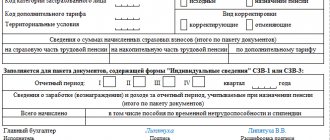Main purpose
Understanding how to create an inventory of documents allows you to establish an organization’s internal records management, which is necessary to control document flow:
- track the movement of documents between departments or outside the company and at any time determine the current location of the document you are looking for;
- optimize the work of the company and a corresponding reduction in resources, both temporary and human, which are spent on searching for the necessary data or restoring lost data.
Each company has the right to independently determine how to organize the movement of documentation, how to make transfer lists and what type they should have. There are no regulatory requirements in this part; there is a recommended form for an inventory of documents for transfer, which you can rely on when developing your own forms.
What is a case register
A specialized document is a separate list of all types of inventories, nomenclatures and other documentation open and maintained in the archives department of a particular company. That is, all cases and documents submitted for responsible archival storage of the organization must be registered - entered into this register.
All Russian organizations, without exception, are required to keep records of documents and ensure their safety. And after a certain period of time, submit the files to specialized archival government institutions. The following requirements are established:
- Federal Law No. 125-FZ of October 22, 2004;
- the basic Rules for the operation of archives of organizations, approved by the decision of the Board of Rosarkhiv dated 02/06/2002.
Clause 6.3.3 of the Rules states that the register of case inventories in the archive is one of the key documents. Its form is fixed in Appendix No. 26. The current form consists of a title page and an accounting register table.
Transfer inventory, sample 2021
The form of the transfer inventory is approved by an internal act of the organization. It is desirable that it include the following sections:
- name of the organization where the documentation comes from;
- name of the organization where the package is being sent;
- date of compilation of the list;
- the serial number of each transferred unit in the package, its name, the number of sheets and copies - this information can be presented in the form of a table. It is advisable to indicate in it whether originals or copies are being transferred, and if copies, then certified or not;
- total number of sheets to be transferred;
- FULL NAME. and the position of the person transferring the package, and the signature of the recipient, as evidence that it was transferred.
The inventory is drawn up in two copies: for the transmitting and receiving parties.
If after filling out the form there are still empty lines, they should be crossed out with a pen.
Sample of compiling an inventory of documents of a personal file
The title indicates the name of the inventory and the details of the employee whose personal records are being described. It also contains the name of the employing company.
Next, a list of inventory documents is drawn up in a table:
- document number in order,
- then its index (or number according to the internal document flow of the enterprise),
- date of preparation and signing,
- title, i.e. the name of the document (this is where the original or a copy is written),
- sheet numbers,
- notes, which usually indicate the condition of the document, the dates and reasons for its withdrawal and return, etc. information.
Below the table, the number of documents in the personal file is indicated in words.
At the end, the inventory is certified by the personal signature of the person responsible for the maintenance and storage of the employee’s personal files (indicating his position and deciphering the autograph).
Main varieties
There are several possible classifications of the lists attached to the shipment. It is recommended that organizations develop their own template for each type. Depending on what kind of transfer the list accompanies, it may include:
- to internal, if papers are transferred within a legal entity from one division to another;
- to external ones, if it accompanies a package of papers sent to another organization.
Depending on the subject of the accompanying papers:
- financial statements;
- personnel papers;
- statutory documentation.
This list of types is not closed; each aspect of the organization’s activities is accompanied by a certain document flow that needs to be organized.
Finally, a special type of list is identified - delivery notes, drawn up for transferring a case to the archive, an example of which will be considered separately.
Step-by-step instruction
Friends, here is a plan of what we have to do to create a convenient and functional document registry:
- Create a new document, give it a name and save it as “Macro-enabled workbook.”
- Select the approximate range of values, select the “Insert” section, the “Table” element, and confirm the presence of headers.
- Fill in the heading names. In my case, these are “Number”, “Customer”, “Folder”, “Title”, “Document” and “Directory”.
- Let's start filling out the columns.
- The “Number” column is easy to fill out. You need to enter the value 1 in the first line, and 2 in the second, select both filled cells, grab onto the small black square in the lower right corner of the selected area and drag it down the required number of lines. The lower cells will automatically contain values from 1 to ... (depending on us).
- The “Customer” column can be filled in manually or in the manner described for the “Name” column, provided that the customer names are also the names of folders in the shared directory.
- In the “Folder” column, I want to see the address of the folder in which a specific document is located and at the same time make it a link, when clicked on which Excel will transfer me to this folder. To do this, I will use the HYPERLINK function. I will describe it in more detail below.
- I need to display the document names in the Title column, but it takes a long time to enter them all manually. There is a little trick in Excel that allows you to speed up the process significantly and automatically fill the cells with the names of all documents located in the specified folder. This is possible thanks to the “Files” function, look for the algorithm just below.
- The “Document” column will contain a working link to the desired file, clicking on which will trigger its opening. Find out how to do this below.
- The “Directory” column is the same folder address, but without a hyperlink. It is needed to fill in the previous columns.
Folder
To get the active address of the folder where the desired document is located, use the “Hyperlink” function:
- Place the cursor in the first cell of the corresponding column.
- Copy the address of the desired folder.
- We paste it directly into the “Directory”, it will be useful in the future.
- Click on fx in the value line and find the desired function or enter manually = HYPERLINK (“folder address”).
- Another method, in my opinion, is the most convenient - right-click in the desired cell (right mouse button), select the “Hyperlink” command from the menu, find the desired folder in the wizard that opens and confirm the action.
- This will have to be done for each document, but if you consider that a large number of them are located in the same folder, then the process should not take much time. For subsequent documents that are neighbors of the first one in the directory, the address can simply be copied.
Name
The name is a little more complicated:
- We add another backslash and an asterisk to the address we placed in the “Directory”, that is, \*.
- Select the “Formulas” menu section, the “Name Manager” function.
- And in its wizard there is the “Create” command.
- Set a name, in my case it will be “Title”.
- In the “Range” line we write =FILES (and click the cursor on the corresponding cell in the “Directory” column, close the bracket).
- Click OK and “Close”.
- Place the cursor in the first cell of the column.
- We enter the formula =INDEX(Name;ROW()-1), where Name is the name we specified at the fourth step of this algorithm, and -1 means that this cell is the second in the column.
- Press “Enter” and see that the names of all files located in the specified folder appear in the column.
- Using this method, you can place the names of not all files in the registry, but selectively depending on the format. To do this, first write the file extension in the folder address indicated in the “Directory” column after the asterisk, for example, \*docx, xls or jpeg. This is true when files of different formats are mixed in one folder - tables, pictures, text documents and any others.
If there is something you don’t understand from my pictures and description, then watch the following detailed instructions in video format.
Document
Friends, the “Document” column contains the same name, but it is a link. To achieve this, you should do all the same steps as in the previous algorithm up to step 8. We will omit them, since there is no need to do the same thing over and over again. Now let's complicate the formula a little. It will take the form =HYPERLINK(INDEX(Name,ROW()-1)). After placing it and entering it, the lines will be filled with the same names, but they are active links.
That seems to be all. I tried to describe the algorithm in as much detail as possible. I was recently asked how to create a register of information about the income of individuals, that is, to generate 2-NDFL certificates and keep records of them in the “Legal Taxpayer” program. The topic is, in general, the same, but the program is different, so I decided to devote a separate material to it. See you soon.
How to correctly compile a list of papers for internal transfer
The internal inventory of documents (when transferring documents between departments of the organization, this is exactly what is drawn up) should be compiled in the form of a table. The form of the table and the amount of information that must be entered into it are determined by the company’s internal administrative documents. When considering how to correctly compile an inventory of documents for transfer, you should include the following sections:
- serial number of paper;
- index - an optional element of details, placed in exceptional cases when a large volume of documentation is transferred;
- date - refers to the date of registration of the paper, that is, the day when it was accepted for accounting in office work;
- title - should briefly reflect the essence of the paper;
- sheet numbers - the sheets of the transferred package must have continuous numbering, each act occupies one or another range of pages of the case;
- note - the field is provided in case the clerk needs to make any additional notes regarding a specific sheet;
- the total number of sheets in the transferred file;
- date of compilation, position, full name. and the signature of the originator.
You can use the following form and sample document transfer inventory:
What does a list of documents for sending by mail look like?
When corresponding with tax authorities, extra-budgetary funds and other authorities, many resort to. To confirm the fact that a set of certain documents has been sent, it is necessary to draw up an inventory in 2 copies, on one of which the postal employee puts a special stamp, the date of sending and his signature.
The inventory form used for postal items is regulated by law. This is form 107, which is available at any post office (approved by the order of the Federal State Unitary Enterprise “Russian Post” “On approval of the procedure for receiving and delivering internal registered mail” dated May 17, 2012 No. 114-p). However, this does not prevent anyone from developing their own inventory form. The main thing is that it contains all the main details of Form 107.
A sample of how to create an inventory of documents for mail is available here.
When transferring documents to the Federal Tax Service, an inventory of them will also be required. ConsultantPlus experts tell you in detail how to compose it correctly. Get free demo access to K+ and go to the Ready Solution to find out all the details of this procedure.
Termination of an employment contract by sending a resignation letter by mail must also be accompanied by an inventory. Read about this in the article “Termination of an employment contract at the initiative of the employee .
Delivery list of documentation
This is a special type of accompanying documentation compiled in connection with the transfer of the case to the archive. These lists contain additional columns:
- deadline dates - you must indicate until what date the paper should be stored. The date is determined in accordance with the archival storage norm, as a rule, it is five years;
- shelf life.
We recommend making an inventory of the documents being transferred and filling it out according to the template.
Registry rules
When registering the journal, the following rules must be observed:
when filled in by different people, the last column indicates who made the edit- technical errors in the registry are eliminated only on behalf of senior management
- when correcting inaccurate data, a written statement is written with information about the type of error and the person who made it
When registering the register in writing, the responsible person puts not only his signature, but also his personal seal. In many companies, the journal is kept electronically. This allows you to quickly find information about documents and keep track of papers.
An organization can simultaneously use a register in both written and electronic form. This option helps to avoid loss of information when a computer or server fails.
Specific design recommendations are given individually. When maintaining a register of agreements, it is required to indicate in the table not only the name and content, but the amount and duration of the document, as well as information about the parties who entered into the agreement.
Features of some types in the video:
Filling procedure
The structure of the register of case inventories consists of two parts: a title page and a table. The procedure for filling out the document is specified in clause 6.3.3 of the Rules.
Step 1. Title page:
- name of the organization - enter the name of the enterprise or institution in which the register is opened;
- it is allowed to indicate in brackets the structural unit of the organization, if necessary;
- register start date - enter the date in the format “DD.MM.YYYY”, the value corresponds to the day the document was opened;
- end date - filled in according to the actual day the accounting register is closed.
Step 2. Register table:
- serial number - enter the number of the entry recorded in the journal, observing the chronological order;
- number of the fund in which the accounting documentation was created;
- inventory number and its name - we fix the values based on the registered case;
- number of cases in the form - we register the data, and we detail the information by documentation category;
- years - periods for which the registered nomenclature was kept;
- number of volumes and copies of the registered file - we fix the quantity based on actual availability;
- notes - we enter additional information about registered cases.
At the end of the calendar year, it is necessary to take stock. The responsible employee must calculate as of January 1 of the following year how many accounting units are stored in the archive according to this register. Separately highlight cases with permanent and temporary storage periods. And also detail the number of to-do lists for the personnel of the enterprise. The final data is certified by the responsible employee and the manager.










